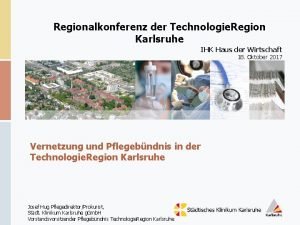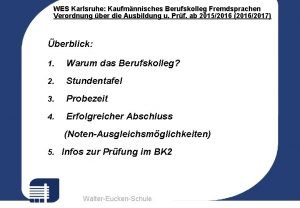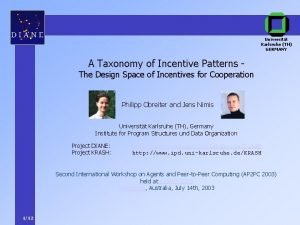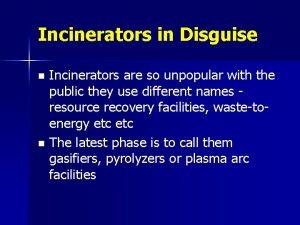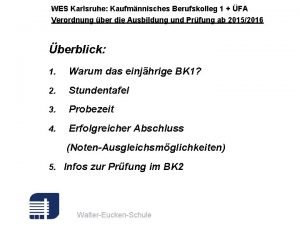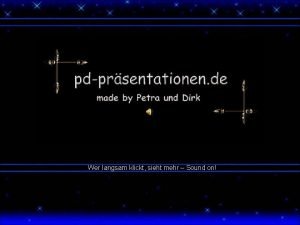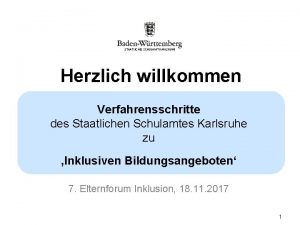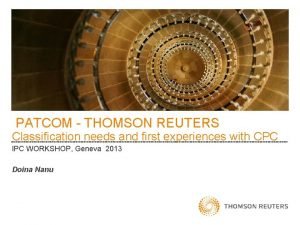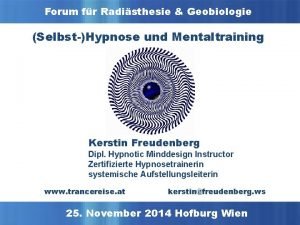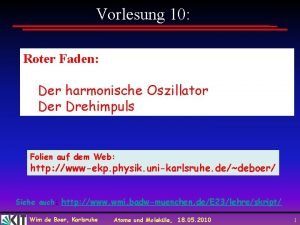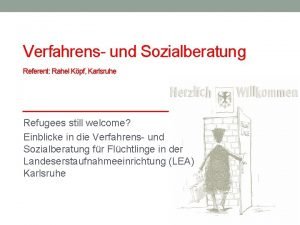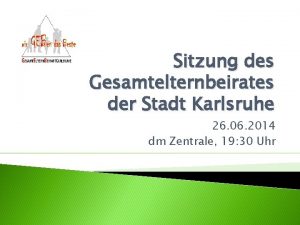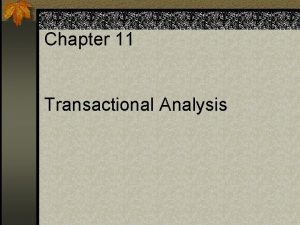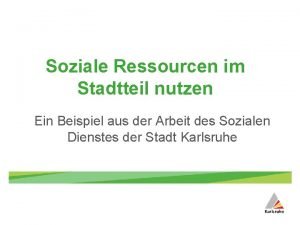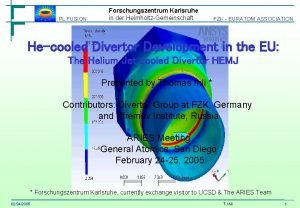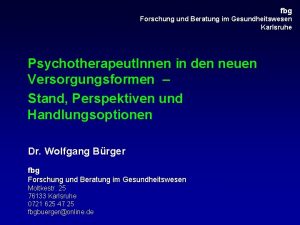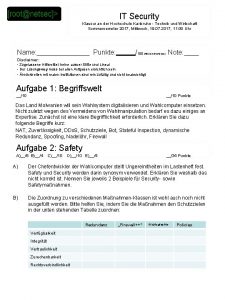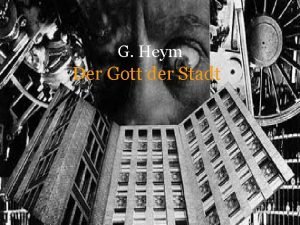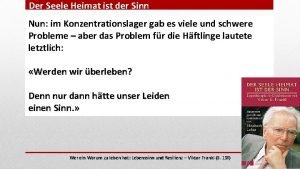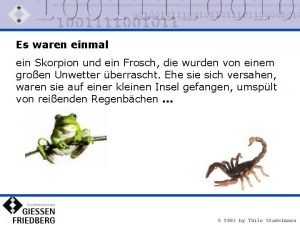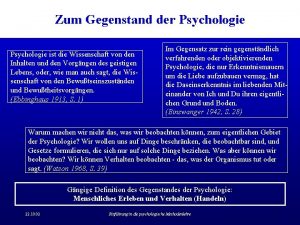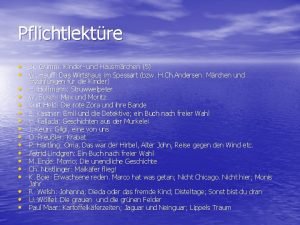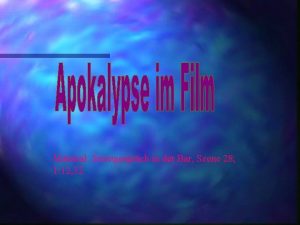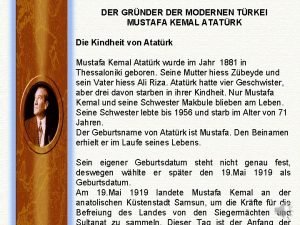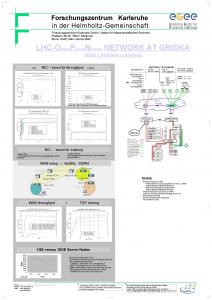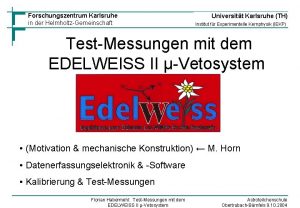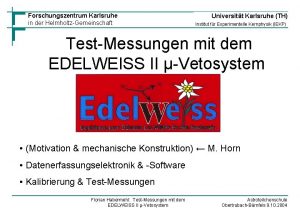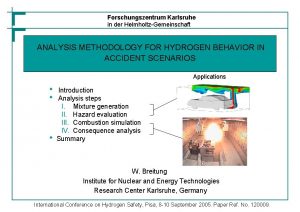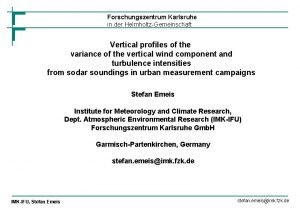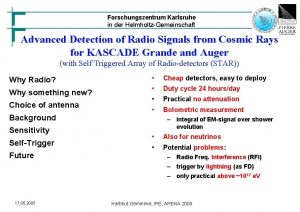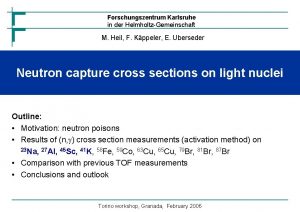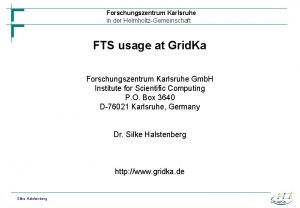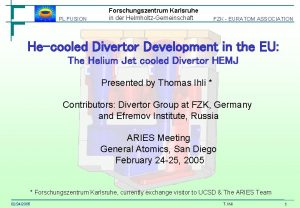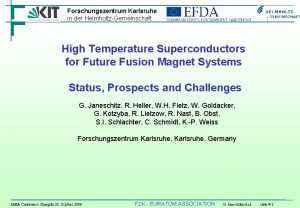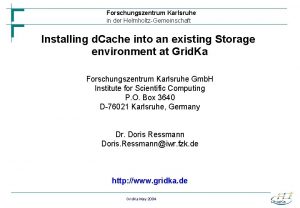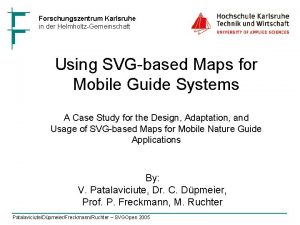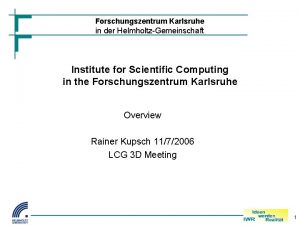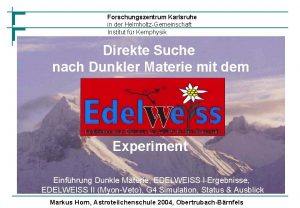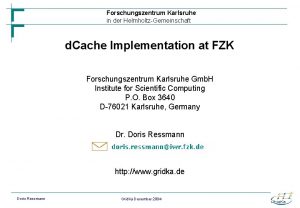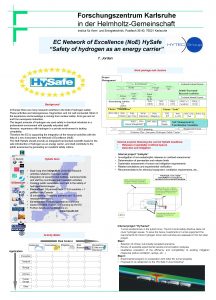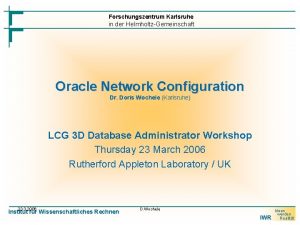Forschungszentrum Karlsruhe in der HelmholtzGemeinschaft ANALYSIS METHODOLOGY FOR































- Slides: 31

Forschungszentrum Karlsruhe in der Helmholtz-Gemeinschaft ANALYSIS METHODOLOGY FOR HYDROGEN BEHAVIOR IN ACCIDENT SCENARIOS Applications • • • Introduction Analysis steps I. Mixture generation II. Hazard evaluation III. Combustion simulation IV. Consequence analysis Summary W. Breitung Institute for Nuclear and Energy Technologies Research Center Karlsruhe, Germany International Conference on Hydrogen Safety, Pisa, 8 -10 September 2005. Paper Ref. No. 120009.

OBJECTIVES • The outcome of a hydrogen related accident depends on many parameters and complex physics • Need to develop a mechanistic understanding and complete modelling procedure - to predict accident progress and consequences - to develop efficient mitigation measures - to support development of safe hydrogen technologies - to provide reliable data base for rules, codes and standards • Paper describes approach and current status of FZK analysis methodology

ANALYSIS METHODOLOGY • FZK develops numerical codes and methods for consistent analysis of hydrogen behavior in accident scenarios, four main steps: COMBUSTIBLE MIXTURE GENERATION Problem geometry CRITERIA FOR HAZARD POTENTIAL COMBUSTION SIMULATION Flammability y Mitigation Flame acceleration y Scenario Sources Distribution GASFLOW CONSEQUENCE ANALYSIS Detonationtransition y GP Program • More than 150 person-years of experience Slow deflagration Slow FLAME 3 D Fast turbulent deflagration COM 3 D Detonation DET 3 D Mechanical and thermal loads Structural response SDO ABAQUS Human effects

I. MIXTURE GENERATION • • • Scenario: Release of cold GH 2 (22 K) from LH 2 -tank at bottom of vehicle, parked in garage Sources: 1 W energy deposition, 170 g GH 2/d, assume 5 x 34 g H 2 releases What is effect of release rate on risk? COMBUSTIBLE MIXTURE GENERATION Problem geometry Mitigation Scenario Case 1: Sources Distribution GASFLOW 3, 4 g H 2/s for 10 s cloud 4% hydrogen

MIXTURE GENERATION : Case 2 • GH 2 source of 0, 34 g H 2/s for 100 s duration cloud 4% hydrogen

II. HAZARD POTENTIAL • What hazard is actually presented by the calculated H 2 -air distribution ? CRITERIAFOR CRITERIA HAZARD POTENTIAL Flammability y • Hydrogen hazard is mainly determined by the fastest possible combustion regime of the mixture - slow deflagration - fast turbulent deflagration - detonation Flame acceleration Flame y Detonation on -set transition y y GP-Program • Transition criteria were developed to estimate conservative (fastest) combustion regime possible for a given H 2 -air mixture and geometry - inert /slow - slow/fast - deflagration/detonation

GP-CODE • All criteria implemented in interactive 0. 8 GP-code, are function of 0 p 0, T 0, x. H 2, x. O 2, x. H 2 O, x. N 2, D - mixtures above 60 vol% are inert - flammability and flame acceleration limits nearly coincide on the rich side - the DDT limit is scale dependent, in larger system (D) wider range of mixtures can undergo a deflagrationto-detonation transition 0. 7 Volume fraction hydrogen • Example for H 2 -air-steam mixtures p = 0. 1 MPa T = 400 K 0 0. 6 0. 5 D = 1 m D = 5 m 0. 4 0. 3 DDT limit 0. 2 Flame acceleration limit 0. 1 0. 0 Flammability limit 0. 0 0. 1 0. 2 0. 3 0. 4 0. 5 Volume fraction steam 0. 6

HAZARD EVALUATION FOR GARAGE EXAMPLE • Criteria are evaluated on-line in GASFLOW from known H 2 -distribution • CASE 1: - significant and stable volume of - combustible mixture potential for flame acceleration and DDT exists during and shortly after release • CASE 2: - only small volume is able to support deflagrations, disappears shortly after end of release - no DDT hazard - inherent mixing mechanisms sufficient to dilute source • H 2 release in confined spaces tolerable up to certain critical rate (here approx. 0. 3 g/s), larger rates require additional measures for hazard control 3. 4 g H 2/s, 10 s 0. 34 g H 2/s, 100 s

III. COMBUSTION SIMULATION • Different physics involved in different combustion modes • Three CFD codes under development and in use at FZK Slow deflagration Slow FLAME 3 D • Codes model stable combustion regimes, transition phenomena covered by criteria Fast turbulent tion deflagra COM 3 D Detonation DET 3 D

LOCAL EXPLOSION IN CONFINED VOLUME COMBUSTIBLE MIXTURE GENERATION Plant geometry Mitigation Scenario Sources Distribution GASFLOW CRITERIA FOR HAZARD POTENTIAL Flammability y • Test chamber at FZK for hydrogen Air supply release and local explosion experiments in confined spaces under controlled flow conditions - volume 160 m 3 - air ventilation up to 24, 000 m 3/h Duct work Flame acceleration y Detonation on -set y GP -Program COMBUSTION SIMULATION Slow deflagration FLAME 3 D Fast turbulent deflagration deflagra COM 3 D Detonation DET 3 D CONSEQUENCE ANALYSIS Mechanical and thermal loads Structural response ABAQUS Human effects • Structural stability against dynamic pressure loads tested under conservative conditions Test chamber - stoichiometric, homogeneous mixture - locally concentrated in cube (2 -16 g H 2) - obstacles in cubes to reach high flame speeds Lower compartment

COM 3 D SIMULATION FOR FZK TEST CHAMBER • Fast local turbulent H 2 deflagration in FZK test chamber - 8 g H 2 - p 0 = 0. 1 MPa - x. H 2 = 29. 8 vol% - air • Numerical simulation

IV. CONSEQUENCE ANALYSIS • Output of CFD combustion calculation allows estimate of consequences CONSEQUENCE ANALYSIS Sensor 16 wall, far Sensor 20 wall, near Mechanical and thermal loads Structural response SDO ABAQUS Sensor 14 floor Sensor 6 upper corner Human effects • Example: Pressure loads of 8 g H 2 test in FZK facility

STRUCTURAL RESPONSE: Test chamber • Response of FZK test chamber simulated with ABAQUS - input : p(t) at 8000 locations from COM 3 D - output: stress and strain in test chamber components • Maximum displacement in frame (mm) • Maximum stress in inner wall (MPa) • Results: Walls and framework structure can confine tested fast local combustions, limiting hydrogen mass for test chamber estimated with model

STRUCTURAL RESPONSE: Damage thresholds for civil buildings • Comparison of measured blast wave parameters in FZK test chamber to known damage limits of civil buildings. Dp+ Positive overpressure Dp+ [Pa] 106 Unconfined gaseous detonations t 16 g H 2 2 g H 2 105 Partial demolition 50%-75% of walls destroyed FZK experiments 16 g H 2 Major structural damage, some wrenched load bearing 2 g H 2 104 members fails Minor structural damage wrenched joints and partitions glass breakage 103 100 I+ 101 102 103 104 Positive impulse I+ [Pa*s] • p-i data from W. E. Baker et al • Gaseous detonation data from Dorofeev et al

HUMAN EFFECTS: Injury thresholds • Comparison of measured blast wave parameters Dp+ and T+ in FZK test chamber to known injury thresholds T+=2 I+/Dp+ I+ 106 Positive overpressure Dp+ [Pa] Unconfined gaseous detonations 16 g H 2 Lung rupture 2 g H 2 105 NASA T+ t 50% ear drum rupture 16 g H 2 FZK experiments Lethality from whole body impact (60 kg body weight) ear drum rupture 2 g H 2 Skull fracture (60 kg body weight) 104 Temporary ear threshold shift 103 10 -4 10 -3 10 -2 10 -1 Positive impulse duration T+ [s] 100 -Threshold 101 data converted from W. E. Baker et al - Gaseous detonation data from S. B. Dorofeev et al

SUMMARY • A mechanistic analysis procedure for hydrogen behavior in accidents was developed, the methodology is based on 3 d CFD tools, it addresses four main steps: - combustible mixture generation - hazard evaluation - combustion simulation - consequence analysis • Two examples for hydrogen behavior in confined spaces were presented: - hydrogen release is safe up to a critical release rate, which depends on problem details and which can be evaluated with 3 D simulations - blast effects from local explosion of 2 - 16 g of GH 2 can cause a) only minor damage to normal civil buildings (glass breakage, joints, . . . ), b) ear damage, more serious injuries appear unlikely (lung rupture, …)

Forschungszentrum Karlsruhe in der Helmholtz-Gemeinschaft Thank you for your attention on behalf of the whole team Dr. A. Denkevits, IKET DI. J. Grune, Pro Science Dr. A. Friedrich, Pro. Science Dr. T. Jordan, IKET Fr. B. Kaup, IKET Dr. A. Kotchourko, IKET Dr. M. Kuznetsov, IKET Dr. A. Lelyakin, IKET Dr. G. Necker, Pro. Science Dr. R. Redlinger, IKET Dr. P. Royl, IKET DI (FH). K. Sempert, Pro. Science Dr. J. Starflinger, IKET Dr. S. Stober, IKET DI (FH). G. Stern, Pro. Science Dr. J. R. Travis, Ing. Büro DPT Fr. DI. A. Veser, Pro. Science DI. J. Yanez, IKET

DISCUSSION MATERIAL

HYDROGEN RELATED ACCIDENTS : What happens? 70 % of incidents 40 30 20 10 0 no ignition slow defl. fast defl. partiall or fully conf. release % of incidents 50 40 30 20 10 0 full spectrum of flame speeds observed 2, 5 2 degree of confinement is important injuries deaths 1, 5 1 0, 5 0 no release, reaction in system 100 90 80 70 60 50 40 30 20 10 0 60 % of incidents open environ. detonat. 70 LH 2 100 90 80 70 60 50 40 30 20 10 0 release w/o ign. affected persons per incident GH 2 % of incidents 60 50 Person damage Effect of geometry affected persons per incident Combustion regimes release with slow defl. . no release with to fast defl. . environm. . 2, 5 2 1, 5 1 0, 5 0 consequences vary significantly Kreiser et al, IKE 2 -116, Univ. Stuttgart, 1994

GENERAL ACCIDENT PHASES air outlet Whats new about hydrogen ? air inlet 100 ppm H 2 gas release mixing with air 4% H 2 (LEL) ignition laminar deflagration fast turb. deflagration detonation

SAFETY RELEVANT PROPERTIES • Hydrocarbons show similar property profiles • The property differences to hydrogen reach almost a factor 10 in each of the accident phases Hydrogen specific safety investigations are needed

SAFETY RELEVANT PROPERTIES: ANOTHER VIEW 1, 5 5 Safety relevant properties of density 1, 0 rair-r gas (kg/m 3) kg/m 3 - hydrogen - natural gas dry - propane - gasoline vapour 3 2 1 hydrogen 0, 3 0, 15 0, 1 0, 05 0 hydrogen natural gas dry propane F=1 50 40 30 0 natural gas dry propane gasoline vapour hydrogen natural gas dry 120 gasoline vapour detonationsensitivity l-1 0, 1 100 1, 5 propane 0, 12 0, 08 1/mm 2 flammability limit specific combustion heat MJ/kg 2, 5 Benzindampf 10 140 laminar flame velocity Propan 20 hydrogen 3 Erdgas trock. 60 0 gasoline vapour -2, 0 70 F=1 0, 2 -1, 5 80 ignition energy UEL-LEL (%) 0, 4 -1, 0 -3, 0 Wasserstoff -3, 5 gasoline vapour 0, 25 m. J cm 2/s propane 0, 3 0, 5 m/s natural gas dry 0, 35 diffusioncoefficient 0, 6 0, 0 -0, 5 -2, 5 0 0, 7 buoyancy 0, 5 4 80 F=1 0, 06 60 0, 04 1 40 0, 5 20 0, 02 0 0 0 hydrogen natural gas dry propane gasoline vapour

GASFLOW VERIFICATION COMBUSTIBLE MIXTURE GENERATION Plant geometry Mitigation Scenario Sources Distribution GASFLOW CRITERIA FOR HAZARD POTENTIAL Flammability y Flame acceleration y Detonation on -set y GP -Program COMBUSTION SIMULATION Slow deflagration FLAME 3 D Fast turbulent deflagration COM 3 D Detonation DET 3 D CONSEQUENCE ANALYSIS Mechanical and thermal loads Structural response ABAQUS Human effects • 3 d code GASFLOW used and developed at FZK for hydrogen distribution simulation. Large verification matrix:

EXAMPLE FOR GASLOW VERIFICATION COMBUSTIBLE MIXTURE GENERATION • Blind CFD pressure predictions for Th 7 in THAI facility in German Benchmark Exercise Plant geometry 0. 18 Mitigation Scenario Sources Distribution GASFLOW STAR - CD CRITERIA FOR HAZARD POTENTIAL 0. 16 Flammability y CFX Flame acceleration Detonation on -set y GP -Program COMBUSTION SIMULATION Slow deflagration FLAME 3 D Fast turbulent deflagration COM 3 D Pressure [MPa] y 0. 14 0. 12 GASFLOW Gothic Detonation DET 3 D Fluent CONSEQUENCE ANALYSIS Mechanical and thermal loads 0. 10 Structural response ABAQUS Human effects Experiment Time [sec]

EXAMPLE FOR COM 3 D VERIFICATION COMBUSTIBLE MIXTURE GENERATION Plant geometry Mitigation • Extensive validation of COM 3 D on analytical solutions, single effect tests, and integral experiments Scenario Sources CRITERIA FOR HAZARD POTENTIAL Flammability y Flame acceleration y Detonation on -set y GP -Program COMBUSTION SIMULATION Slow deflagration FLAME 3 D Fast turbulent deflagration COM 3 D Detonation DET 3 D CONSEQUENCE ANALYSIS Mechanical and thermal loads Structural response ABAQUS Human effects • Example for turbulent deflagration simulation in obstructed tube - length 12 m - diameter 350 mm - mixture = - p 0 = - T 0 = - BR = 16 experiment simulation 12 Pressure transducer position [m] Distribution GASFLOW 8 4 0 -0. 05 -0. 025 0 Time [ms] 0. 025 0. 05

EXAMPLE FOR DET 3 D VERIFICATION COMBUSTIBLE MIXTURE GENERATION Plant geometry • DET 3 D developed and verified for simulation of stable H 2 -air- steam detonations in complex domains Mitigation Scenario FZK- ICT detonation experiment Sources Distribution GASFLOW CRITERIA FOR HAZARD POTENTIAL Flammability y Flame acceleration y Detonation on -set y GP -Program COMBUSTION SIMULATION Slow deflagration FLAME 3 D Fast turbulent deflagration COM 3 D Detonation DET 3 D CONSEQUENCE ANALYSIS Mechanical and thermal loads Structural response ABAQUS Human effects D = 6 m H 2 -air F=1 Dt=0. 4 ms D=1940± 20 m/s

6. 3418 0. 05 bar 6. 0134 0. 05 bar 5. 4552 0. 05 bar 4. 4974 4. 4617 0. 05 bar 4. 0336 0. 05 bar 3. 7044 0. 1 bar 3. 39 3. 2919 0. 1 bar 0. 05 bar 2. 9289 2. 8035 0. 1 bar 2. 3688 0. 1 bar 1. 441 0. 182 0. 184 0. 186 0. 188 0. 190 0. 192 Time [s] 0. 194 0. 196 0. 198 0. 1 bar 0. 200 Overpressure [bar] Distance [m] PRESSURE DATA OF 2 g EXPERIMENT IN FZK TEST CHAMBER

6. 3418 0. 2 bar 6. 0134 0. 1 bar 5. 6396 5. 4552 0. 1 bar 4. 4974 4. 4617 0. 1 bar 4. 0336 0. 2 bar 3. 7044 0. 1 bar 3. 39 3. 2919 0. 2 bar 2. 9289 2. 8035 0. 2 bar 2. 3688 0. 5 bar 1. 441 0. 180 0. 185 0. 190 0. 195 Time [s] 0. 200 0. 5 bar 0. 205 Overpressure [bar] Distance, m PRESSURE DATA OF 16 g EXPERIMENT IN FZK TEST CHAMBER

9. 375 0. 02 7. 295 0. 05 5. 255 0. 05 3. 675 0. 1 2. 095 0. 2 1. 315 0. 5 16. 0 g 0. 535 0. 07 0. 08 0. 09 Time [s] 0. 10 1 0. 11 Overpressure [bar] Distance [m] PRESSURE DATA OF UNCONFINED 16 g EXPERIMENT

SINGLE DEGREE OSCILLATOR MODEL Mitigation Scenario Sources Distribution GASFLOW CRITERIA FOR HAZARD POTENTIAL • Example from combustion of a 12% H 2 -air mixture in a large multi-room building, p. AICC = 0. 54 MPa - Flammability y Flame acceleration y Detonation on -set y GP -Program - COMBUSTION SIMULATION Slow deflagration FLAME 3 D - Fast turbulent deflagration COM 3 D Detonation DET 3 D CONSEQUENCE ANALYSIS Mechanical and thermal loads Structural response ABAQUS Human effects - multi-peak structure due to reverberations in burned gas peak pressures are well above AICC-pressure due to prepressurization of unburned gas in multi-compartment building local peak pressures depend on building design and ignition location. effective static pressures significantly higher than applied dynamic peak pressures for oscillators in resonance with multi- peak sequence only for very massiv structures with natural frequencies below 10 Hz is peff close to p. AICC 3. 5 3. 0 2. 5 0. 0 Damping D 0. 007 0 2. 0 peff [MPa] Plant geometry p-p 0 [MPa] COMBUSTIBLE MIXTURE GENERATION 1. 5 1. 0 0. 1 0. 2 Time [s] 0. 3 0. 07 0. 01 p. AICC 0. 5 0 1. 5 0. 4 0 100 200 300 400 Frequency [Hz] 500

STRUCTURAL RESPONSE EXTRAPOLATED • COM 3 D and ABAQUS models were used to predict structural response of test chamber for larger local explosions (64 g H 2) • Maximum plastic strain in frame • Wall displacements • 64 g H 2, 50. 0 ms
 Haus der wirtschaft karlsruhe
Haus der wirtschaft karlsruhe Kaufmännisches berufskolleg karlsruhe
Kaufmännisches berufskolleg karlsruhe Incentive karlsruhe
Incentive karlsruhe Thermoselect karlsruhe
Thermoselect karlsruhe Wes karlsruhe
Wes karlsruhe Karlsruhe schiff
Karlsruhe schiff Schulamt karlsruhe
Schulamt karlsruhe Christiane emmerich fiz karlsruhe
Christiane emmerich fiz karlsruhe Karlsruhe geobiologie
Karlsruhe geobiologie 18 harmonien karlsruhe
18 harmonien karlsruhe Erstaufnahmeeinrichtung karlsruhe durlacher allee 100
Erstaufnahmeeinrichtung karlsruhe durlacher allee 100 Joachim frisch karlsruhe
Joachim frisch karlsruhe Parent ego state
Parent ego state Soziale ressourcen beispiele
Soziale ressourcen beispiele Fzk karlsruhe
Fzk karlsruhe Psychologe karlsruhe kassenzulassung
Psychologe karlsruhe kassenzulassung Wahllokale karlsruhe
Wahllokale karlsruhe Der gott der stadt thema
Der gott der stadt thema Der seele heimat ist der sinn
Der seele heimat ist der sinn Der weg der atemluft
Der weg der atemluft Der skorpion und der frosch
Der skorpion und der frosch Gegenstand der arbeitspsychologie
Gegenstand der arbeitspsychologie Das ist der daumen der pflückt die pflaumen
Das ist der daumen der pflückt die pflaumen Weltuntergangstheorie
Weltuntergangstheorie V
V Mehrheitstext bibel
Mehrheitstext bibel Sorrowing old man painting
Sorrowing old man painting Grnder
Grnder Kontinuitetshantering i praktiken
Kontinuitetshantering i praktiken Novell typiska drag
Novell typiska drag Tack för att ni lyssnade bild
Tack för att ni lyssnade bild Returpilarna
Returpilarna
